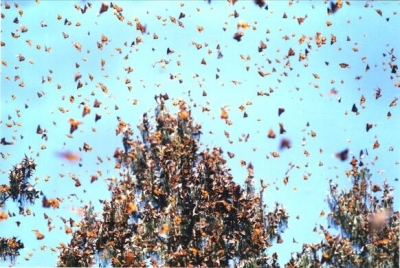
Covering an area of more than 560 sq.km., the Monarch Buttery Biosphere Reserve is located nearly 160 km from Mexico’s capital Mexico City. As the name implies, the Reserve is renowned for the North American monarch butterflies that fill the area during their annual migration. Every year, up to a billion of these butterflies spend the winter at the oyamel fir (a native tree) forests of central Mexico. It is said that the butterflies arrive as dosed packs and land in more than 10 colonies in these forests. The Reserve spans eight of these colonies. In 2008, the Reserve was declared a UNESCO World Heritage Site of “Outstanding Universal Value”. The dramatic decline in the number of migrating monarch butterflies, one of the endangered species of Mexico, over the last few decades has been of grave concern in fact, it is said to have reached a 20-year low during the 2013-2014 season.
An incredible journey
Considered one of the most amazing natural events to happen on our planet, the annual migration of the North American monarch butterflies occurs between their home range in Canada and the U.S. and their winter stop-over in southern California and central Mexico more than 3,000 km away! The epic journey begins around November before cold weather sets in their home range, and when it ends in Mexico, there are about a billion of those butterflies painting the trees a lovely orange and bending their branches under their collective weight. It is said that each complete journey holds within it the cycle of birth and death, meaning that the butterfly that begins the journey need not be the one that returns home. Many males may die before the females lay their eggs and die themselves and the journey is continued by the new generation that bursts forth into the scene. Though there are many theories and ongoing studies on the subject, it has remained a mystery as to how newer generations continue to follow the same route their ancestors did.
Threats
According to the International Union for the Conservation of Nature’s (IUCN) latest assessment cycle, the conservation outlook for the region is that of “significant concern”. It lists three major threats for the butterflies in their range. Among the most critical is the deforestation and degradation of forest by illegal logging of overwintering sites in México. The next is the widespread reduction of breeding habitat in the US due to land-use changes and the decrease of this butterfly’s main larval food plant – the common milkweed. The reduction is deeply connected with the use of a certain herbicide that kills these weeds. The other reason is the extreme weather conditions experienced throughout the butterfly’s range during the year.
Picture Credit : Google




